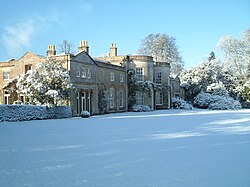Scrope is the name of an old English family of Norman origin that first came into prominence in the 14th century. The family has held the noble titles of Baron Scrope of Masham, Baron Scrope of Bolton, and for a brief time, the Earl of Wiltshire.

East Harptree is a village and civil parish in Somerset, England. It is situated 5 miles (8.0 km) north of Wells and 15 miles (24.1 km) south of Bristol, on the northern slope of the Mendip Hills overlooking the Chew Valley. The parish has a population of 644. The parish includes the hamlet of Coley.
George Edward Waldegrave, 7th Earl Waldegrave was a British peer.
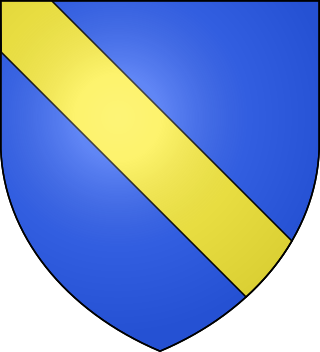
Richard le Scrope, 1st Baron Scrope of Bolton was an English soldier and courtier, serving Richard II of England. He also fought under the Black Prince at the Battle of Crecy in 1346.

Walton Hall is a country house in Walton, Warrington, Cheshire, England. It is recorded in the National Heritage List for England as a designated Grade II listed building. The hall and its surrounding garden and grounds are owned and administered by Warrington Borough Council.

The Church of St Mary Magdalene in Chewton Mendip, Somerset, England, was built in the 1540s and has been designated as a Grade I listed building. It is dedicated to Jesus' companion Mary Magdalene.

Middleton Lodge is a Georgian Palladian mansion set within 200 acres (0.81 km2) of open countryside, on the outskirts of the village of Middleton Tyas, a mile or so off the A1 near Scotch Corner and a 15-minute drive from Darlington, County Durham.
Henry Wildman Kettlewell was British Army officer and an English cricketer. He was a right-handed batsman and right-arm fast bowler who played for Somerset. He was born and died in East Harptree.
Mary Scrope was an English courtier. She was the granddaughter of Henry Scrope, 4th Baron Scrope of Bolton, and the sister of Elizabeth Scrope, wife of John de Vere, 13th Earl of Oxford, and Margaret Scrope, wife of Edmund de la Pole, 3rd Duke of Suffolk. She is said to have been in the service at court of King Henry VIII's first four wives. As the wife of Sir William Kingston, Constable of the Tower of London, she was in attendance on Anne Boleyn during the Queen's brief imprisonment in the Tower in May 1536, and both she and her husband were among those who walked with the Queen to the scaffold. By her first husband, Edward Jerningham, she was the mother of Sir Henry Jerningham, whose support helped to place Queen Mary I on the throne of England in 1553, and who became one of Queen Mary's most favoured courtiers.
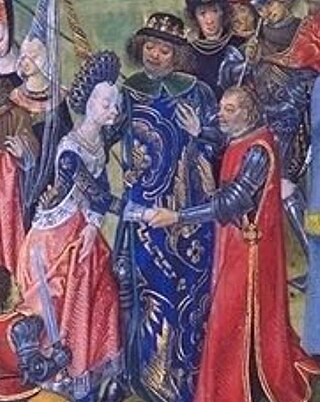
Alice Bures, also known by her married name of Alice Brian and sometimes as Alice de Bryene, was an English landowner whose estates were centred on Suffolk. Widowed about age 26, she spent the next 49 years of her life bringing up her two daughters, looking after her household, and running her estates. Some letters she received and some of her household accounts have been published, giving a valuable insight into the life of a well-off gentlewoman in the English countryside at that time.
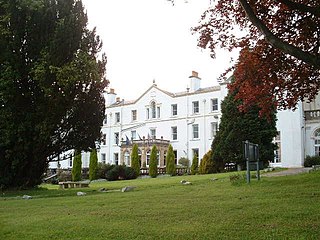
Court Colman Manor is a historic Tudor mansion in Pen-y-fai, Bridgend, South Wales. The property belonged to Margam Abbey until the Dissolution, after which it passed through several hands. It was built in 1766 by Hopkin Rees (1729–1780) and enlarged and modified in 1907 by Robert William Llewellyn (1848–1910).

Elizabeth Laura Waldegrave, Countess Waldegrave, was a British noblewoman, courtier and society beauty. She served at court as a Lady of the Bedchamber to Charlotte, Princess Royal, eldest daughter of King George III. She married her cousin, George Waldegrave, 4th Earl Waldegrave, in 1782.

Narborough Hall is a Grade II* listed building in Narborough in Leicestershire. Believed to date from 1596 this Elizabethan manor house was built by James Meade, a local landowner. However, it was only after it was extensively remodelled in the mid-19th century that it became known as Narborough Hall. It is notable because of its construction from local pink granite.

Underley Hall is a large country house near Kirkby Lonsdale in Cumbria. It was designed in a Jacobean Revival style by the architect George Webster for Alexander Nowell and built between 1825 and 1828, on the site of an earlier house. An additional wing and tower, designed by E. G. Paley and Hubert Austin, were added in 1874.

Chorleywood House Estate is a 64.3 hectare Local Nature Reserve in Chorleywood in Hertfordshire. It is owned and managed by Three Rivers District Council, and the declaring authority is Hertfordshire County Council.

Wadhurst Castle is a 19th-century castellated mansion just to the west of the town of Wadhurst, East Sussex, England, in an elevated position overlooking the countryside to the south. It is a grade II listed building.

Gournay Court in the parish of West Harptree, Somerset, England, is a country house built circa 1600. The house, along with the manor of West Harptree, was owned by the Duchy of Cornwall. During World War I, it became a hospital. In 1928, it was bought by Sir Edward Geoffrey Hippisley-Cox. It is now the residence of the local Member of Parliament (MP) Jacob Rees-Mogg and his family.
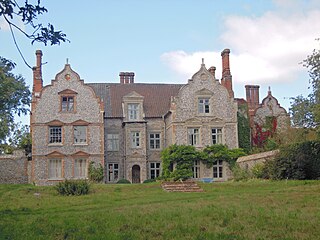
Wiveton Hall is a country house in Wiveton, Norfolk, England. It is Grade II* listed. It was built in 1652 and extended in 1908. However there are remains of an older building in the garden which could date back to 1280. It was the residence of many notable people over the next three centuries and is now the home of the MacCarthy family. The Hall provides holiday cottage accommodation, a restaurant café, a farm and gift shop and has garden tours. The West Wing is available for weddings and other special events.

Nazareth or Nazaret Newton was a courtier and lady-in-waiting.
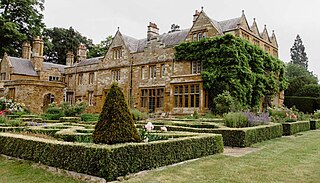
Flore House in Flore, Northamptonshire, is a country house of historical significance and is Grade II listed on the English Heritage Register. It was built in 1608 for the Enyon family and was the residence of notable people over the next four centuries. Today it provides guest accommodation and caters for special events including weddings.
